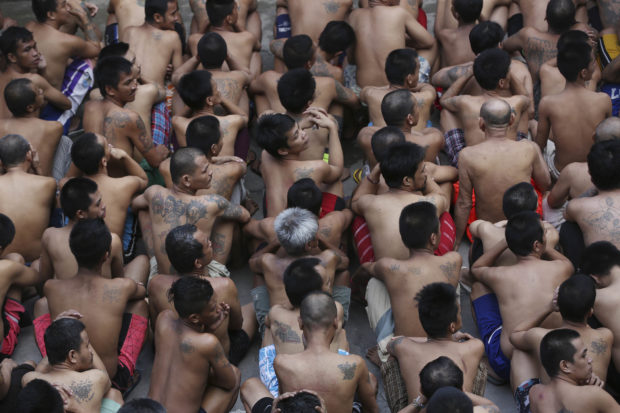Drug war worsened jail overcrowding in 2017, says COA

TOO MANY INMATES A 2017 report of the Commission on Audit showed that jails nationwide, including this Quezon City facility, had a total cell population of 146,302, or seven times greater than the ideal capacity of 20,653. —NIÑO JESUS ORBETA
Overcrowding in the country’s jails — housing suspects who have not even been convicted yet — got worse last year, as the Duterte administration waged its war on illegal drugs.
The Commission on Audit (COA) said the jail congestion rate reached 612 percent last year — worse than the 511 percent logged at the end of 2016.
Total cell population of 146,302 as of Dec. 31, 2017, was seven times greater than the ideal capacity of 20,653, according to the COA’s 2017 annual audit report on the Bureau of Jail Management and Penology (BJMP).
Although detainee population grew 15 percent from 126,946 in 2016, the jail system’s capacity actually shrank a bit from that year’s 20,746.
Ideal standards
Article continues after this advertisementCell capacity is computed according to the ideal standards set by the BJMP in its Manual on Habitat, Water, Sanitation and Kitchen in Jails.
Article continues after this advertisementSet as ideal floor area per inmate is 4.7 square meters, and the maximum number of inmates in one cell should be 10.
Overcrowding in the past two years had been at least twice as bad compared to 11 years ago, the COA said.
For 2007, the audit agency reported a total detainee population of 59,359 against the ideal population of 16,314, or a congestion rate of 264 percent.
Its annual reports for 2008 to 2015 did not take note of congestion nationwide.
The COA cited the “number of drug-related cases in the country” as one of the reasons for the ballooning detainee population. It didn’t provide figures, though.
Many drug-related offenses—including sale, distribution, manufacture and possession of illegal drugs—are punishable by life imprisonment.
Since these are serious offenses, drug suspects could not post bail—unless the evidence is ruled weak—and they could not be released to relieve jail congestion.
Besides the drug cases, state auditors blamed the “court’s slow [sic] or inaction on the pending cases,” causing prolonged detentions.
Their cases could not be disposed of quickly because of the lack of judges, frequent postponement of hearings, and slow pace of cases involving offenses punishable by life imprisonment.
Many detainees do face lighter, bailable charges and could have enjoyed the right to temporary liberty—if only they could afford it.
“Detainees who are below poverty line cannot afford to post bail so they were stocked (sic) in the jails,” the COA said.
Expansion impossible
The BJMP, however, could not cope with the rising detainee population because of limited space in its properties—which meant construction or expansion was “not possible.”
Aside from failing to meet the BJMP standards, auditors said conditions in the country’s jails did not meet the United Nations Standard Minimum Rules for the Treatment of Prisoners.
UN standards state that “minimum floor space, lighting, heating and ventilation” requirements, as well as “climatic conditions,” should be considered.
As a result, the COA said inmates were forced to “hold on to gangs” in order to survive, find protection and social support, and access material benefits.
Congestion also led to unhealthy conditions for the detainees as shown by data over the past three years.
Total number of cases of illnesses jumped to 257,587 in 2017, from 192,987 in 2015.
Urinary tract infections and hypertension were the leading ailments, accounting for 57,269 and 45,665 cases, respectively (compared to 32,143 and 36,394 two years before).
Skin infections—abscesses, scabies, prickly heat, irritant contact dermatitis and fungal infections—were also recorded in the thousands.
ARMM jails not crowded
Regions with above-average congestion rates were: Calabarzon (975 percent), Central Luzon (802 percent), Zamboanga Peninsula (789 percent), Central Visayas (775 percent), Ilocos Region (674 percent), Davao Region (650 percent), and Northern Mindanao (627 percent).
Jail overcrowding in the National Capital Region was logged at 572 percent.
Only the Autonomous Region in Muslim Mindanao (ARMM) had a detainee population below capacity (139 against 275).
The COA stressed that the BJMP must “ensure that the human rights and welfare of inmates are upheld at all times.”
Auditors urged the bureau management to prioritize the construction of new jailhouses, scout for possible lot donations from local governments, or even convert unused office space into additional cells.
They said the BJMP should intensify the Good Conduct Time Allowance process, which provides activities such as livelihood training and alternative learning systems to take some detainees out of the cells at least for a while.
Jail officials should also make more use of the Recognizance Act of 2012—which allows the courts to order the release of indigent detainees who could not afford bail, the report said.
The BJMP released only 36,330 inmates in 2017, fewer than 47,356 in 2015.
New jailhouses
The bureau’s management informed the auditors that it was already building new jailhouses in 16 cities and towns: Quezon City, Las Piñas City, Mandaluyong City, Pasig City and San Juan City in Metro Manila; Alaminos City (Pangasinan) and Tagudin (Ilocos Sur) in Ilocos; Aparri and Ballesteros (Cagayan), Cauayan City (Isabela) and Cabarroguis (Quirino) in Cagayan Valley; Davao City, Digos City (Davao del Sur), Tagum and Panabo City (Davao del Norte), and Montevista (Compostela Valley) in the Davao Region.
Moreover, funds have been set aside for new jailhouses in Calabarzon, Bicol, Eastern Visayas and Zamboanga Peninsula.
The BJMP is an attached agency of the Department of the Interior and Local Government.
Housing convicts in prisons and penal colonies is the function of a different agency, the Bureau of Corrections under the Department of Justice.